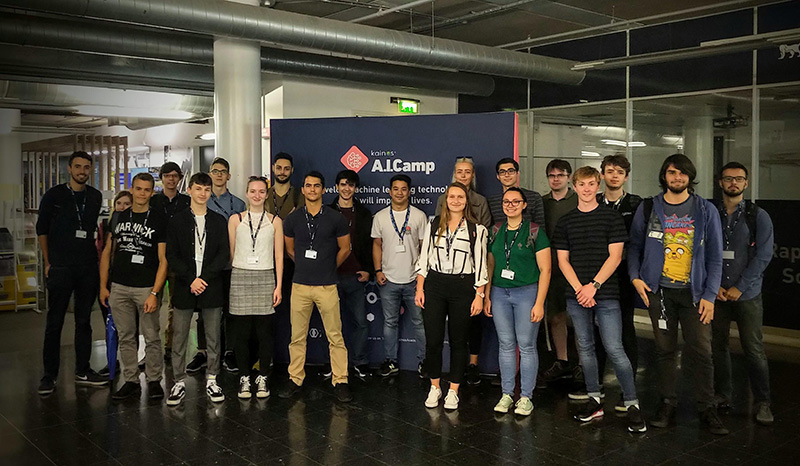Digital services provider Kainos has been inspiring and training some of the next generation of AI experts at an AI training camp at Birmingham City University, in an approach that could prove invaluable.
The 20 undergraduate participants worked on machine learning, chatbots and business skills at the two-week camp in September. The AI campers were judged at a two-day hackathon by a panel that included a Microsoft AI architect and a 15-year-old AI consultant.
Winners Dominic Henjes, Paul Popa and Aleksandr Jermakov, who all study at the University of Birmingham, created an original knowledge-capture system for mathematics which could recognise and convert equations into code. Their system included the creation of an algorithm to digitise handwritten and paper-formatted mathematical equations.
Other notable projects included a system to detect bias in press articles; a tool to predict the UK’s rubbish production; a method for determining more accurate flight times and a tool to predict high-crime areas for route planning.
A solutions provider for the NHS and UK Government, this was Kainos’ first camp in Birmingham. However, last year’s AI camp in Belfast saw job offers go out to all 18 students.
But what makes the camp such an effective tool for AI training?
The makings of a good AI recruit
The task of recruiting a student into AI is quite a challenge, according to Kainos chief technology officer Tom Gray.
“I don’t think anybody really knows everything about what is the best entry-level characteristics for anyone to be a really successful AI engineer because the industry has not been long enough in existence,” he says.
Instead, the company looks at mathematical aptitude and primarily at potential: curiosity, drive, and creativity.
However, he has concerns about the educational pipeline to AI.
“[What] gives me significant concern [is] when we see the intake for maths A-levels decreasing across the UK, for example. We need the pipeline coming through now for AI in physics, as well as ICT,” he says.

Why AI requires different skills to regular programming
Gray explains that although AI might need a different skillset from classical programming, the task of a recruiter is still to inspire and expose those with potential to the basics.
“We would previously have focused more on aptitude for programming, so how do you take a problem and establish a programming solution for it,” he explains.
“But for machine learning, it seems to be a balance of aptitude and more a mathematical background.
“Because rather than being asked to take a problem and break it down into a decision tree, the emphasis becomes more on how do you understand processes, how do you understand what is the best mathematical model.”
“We would previously have focused more on aptitude for programming, so how do you take a problem and establish a programming solution for it.”
Using chatbots at the camp to introduce the concepts of AI
Core to the training’s approach is the use of chatbots as a learning and development tool.
“Machine learning is quite complex so to allow our students to be able to have the sense of making real progress, and to allow them to have something they can show off to family and peers, we focused on using chatbots as an interface,” explains Kainos chief technology officer Tom Gray.
“So fundamentally, we teach people how to make human models and then how we apply it in a chatbot environment.”
Students have developed chatbots on areas such as gluten intolerance to help people understand what things might cause such a health issue, or to help people eat more carefully if they are affected.
Students have also created careers advice chatbots, interviewing other school students so they could build a data set for the bot.
The chatbot challenge has also been applied to astronomy, with a bot that showed people the celestial bodies most likely to be visible in a given place and time.
“There was no restraint on how they use the machine learning technology, we leave it up to their enthusiasm. It leads to better outcomes if they do something they really believe in,” says Gray.
“Fundamentally, we teach people how to make human models and then how we apply it in a chatbot environment.”
Challenging learning conventions
While difficult topics are often associated with the least enjoyment from learners, this was not the case in the AI training camp.
“Students said they really enjoyed the underlying mathematical background to creating a model, they didn’t say it was the easiest part, in fact, it was probably the most challenging part,” says the Kainos CTO.
The Birmingham camp also involved speakers from Microsoft, from Kainos headquarters in Belfast and from Kainos clients, in NHS and government. But the camp has not yet involved formal discussion on the ethics of AI.
Gray says he is very conscious that use of AI and its solutions, particularly working with public bodies, needs to be grounded on an ethical basis.
“But we are not an expert, so we are in the process of identifying what people can bring that ethical framework into what we do. At a general level, we’re probably talking about the philosophy departments in universities or policy people in various government departments. We know we don’t know all the answers.”
Images courtesy of Brolly